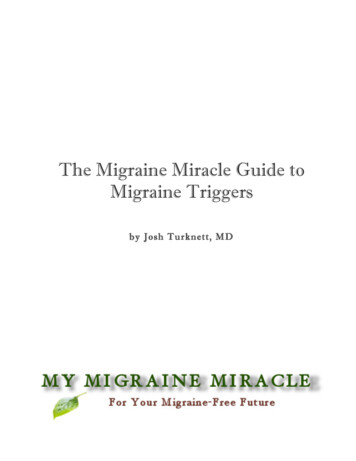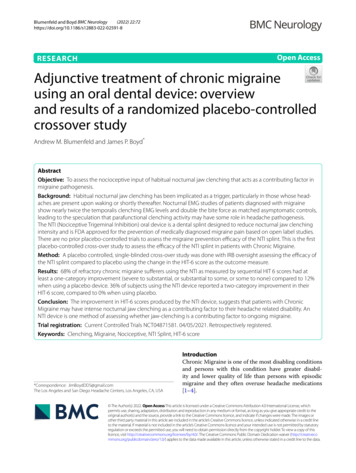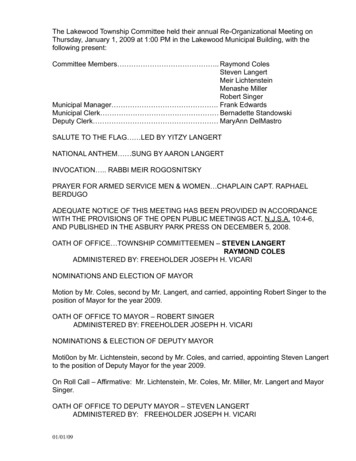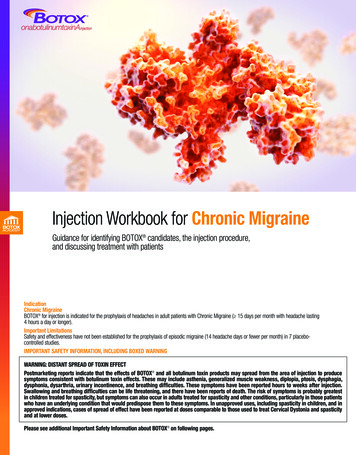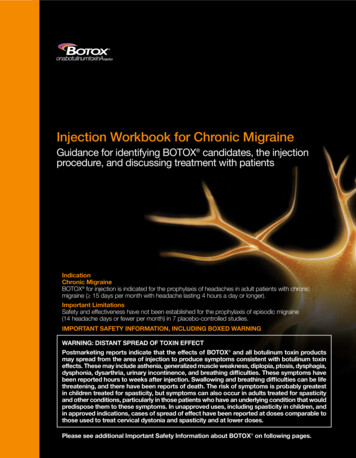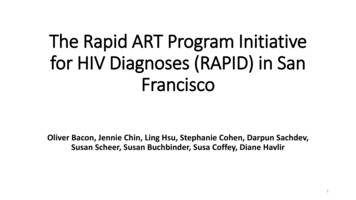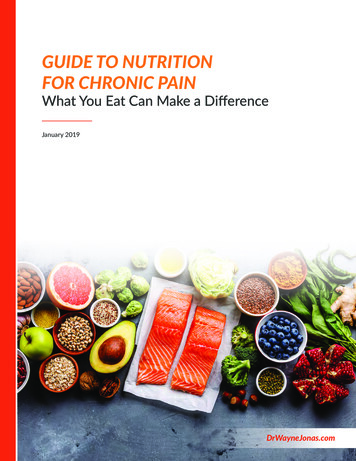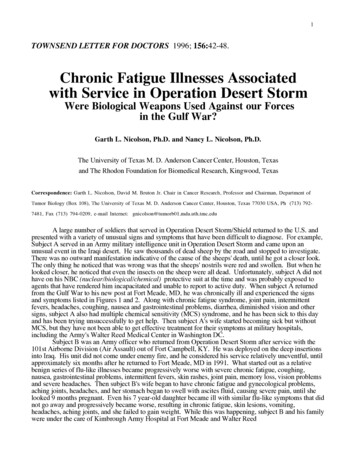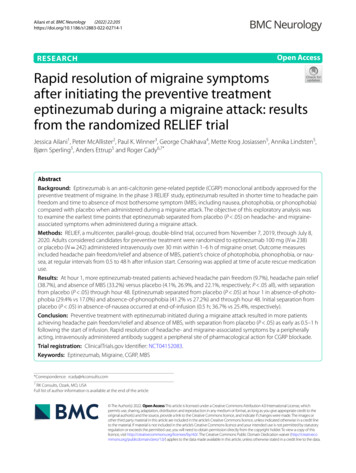
Transcription
(2022) 22:205Ailani et al. BMC 1Open AccessRESEARCHRapid resolution of migraine symptomsafter initiating the preventive treatmenteptinezumab during a migraine attack: resultsfrom the randomized RELIEF trialJessica Ailani1, Peter McAllister2, Paul K. Winner3, George Chakhava4, Mette Krog Josiassen5, Annika Lindsten5,Bjørn Sperling5, Anders Ettrup5 and Roger Cady6,7*AbstractBackground: Eptinezumab is an anti-calcitonin gene-related peptide (CGRP) monoclonal antibody approved for thepreventive treatment of migraine. In the phase 3 RELIEF study, eptinezumab resulted in shorter time to headache painfreedom and time to absence of most bothersome symptom (MBS; including nausea, photophobia, or phonophobia)compared with placebo when administered during a migraine attack. The objective of this exploratory analysis wasto examine the earliest time points that eptinezumab separated from placebo (P .05) on headache- and migraineassociated symptoms when administered during a migraine attack.Methods: RELIEF, a multicenter, parallel-group, double-blind trial, occurred from November 7, 2019, through July 8,2020. Adults considered candidates for preventive treatment were randomized to eptinezumab 100 mg (N 238)or placebo (N 242) administered intravenously over 30 min within 1–6 h of migraine onset. Outcome measuresincluded headache pain freedom/relief and absence of MBS, patient’s choice of photophobia, phonophobia, or nausea, at regular intervals from 0.5 to 48 h after infusion start. Censoring was applied at time of acute rescue medicationuse.Results: At hour 1, more eptinezumab-treated patients achieved headache pain freedom (9.7%), headache pain relief(38.7%), and absence of MBS (33.2%) versus placebo (4.1%, 26.9%, and 22.1%, respectively; P .05 all), with separationfrom placebo (P .05) through hour 48. Eptinezumab separated from placebo (P .05) at hour 1 in absence-of-photophobia (29.4% vs 17.0%) and absence-of-phonophobia (41.2% vs 27.2%) and through hour 48. Initial separation fromplacebo (P .05) in absence-of-nausea occurred at end-of-infusion (0.5 h; 36.7% vs 25.4%, respectively).Conclusion: Preventive treatment with eptinezumab initiated during a migraine attack resulted in more patientsachieving headache pain freedom/relief and absence of MBS, with separation from placebo (P .05) as early as 0.5–1 hfollowing the start of infusion. Rapid resolution of headache- and migraine-associated symptoms by a peripherallyacting, intravenously administered antibody suggest a peripheral site of pharmacological action for CGRP blockade.Trial registration: ClinicalTrials.gov Identifier: NCT04 152083.Keywords: Eptinezumab, Migraine, CGRP, MBS*Correspondence: rcady@rkconsults.com7RK Consults, Ozark, MO, USAFull list of author information is available at the end of the article The Author(s) 2022. Open Access This article is licensed under a Creative Commons Attribution 4.0 International License, whichpermits use, sharing, adaptation, distribution and reproduction in any medium or format, as long as you give appropriate credit to theoriginal author(s) and the source, provide a link to the Creative Commons licence, and indicate if changes were made. The images orother third party material in this article are included in the article’s Creative Commons licence, unless indicated otherwise in a credit lineto the material. If material is not included in the article’s Creative Commons licence and your intended use is not permitted by statutoryregulation or exceeds the permitted use, you will need to obtain permission directly from the copyright holder. To view a copy of thislicence, visit http:// creat iveco mmons. org/ licen ses/ by/4. 0/. The Creative Commons Public Domain Dedication waiver (http:// creat iveco mmons. org/ publi cdoma in/ zero/1. 0/) applies to the data made available in this article, unless otherwise stated in a credit line to the data.
Ailani et al. BMC Neurology(2022) 22:205BackgroundMigraine has been shown to be among the most disabling disorders worldwide, and it continues to be amajor deterrent of health [1]. The age group with thehighest burden of disease (as estimated by years livedwith a disability) is 15–49 years, representing a periodwhen family, education, and career building are of toppriority [1]. Despite receiving preventive treatment,patients may still require acute migraine medicationbecause of delayed onset of effect of the preventivemedication, or because the preventive treatment failedto adequately prevent the bothersome symptoms ofmigraine. Approximately 65% of patients with migrainehave reported experiencing all three cardinal-associated symptoms of migraine: nausea, photophobia, andphonophobia, which comprise the options for patientselection of most bothersome symptom (MBS) [2]. Inaddition to headache pain freedom, efficacy trials oftenuse MBS freedom as a co-primary or key secondaryefficacy endpoint [2].Eptinezumab, a humanized IgG1 monoclonal antibody that binds rapidly, durably, and with high affinity to calcitonin gene-related peptide (CGRP) [3], isapproved for the preventive treatment of migraine inadults [4]. Eptinezumab provides sustained blockade ofthis key neuropeptide’s interaction with its receptor [3]and, having a molecular weight of 140 KD, is believednot to cross the blood–brain barrier [5], yet has demonstrated rapid and sustained efficacy in preventing migraine [6–9]. This effect may aid in elucidatingperipheral versus central migraine mechanisms important to understanding the pathophysiology of migraineas well as the pharmacological site of action for treatment approaches that inhibit CGRP signaling [10].RELIEF, a phase 3, multicenter, double-blind trialin patients experiencing migraine 4–15 days/month,found that eptinezumab, when administered duringa migraine attack, demonstrated benefit by reducingheadache, migraine-associated symptoms, and rescue medication use compared with placebo [7]. At 2 hafter infusion start, more eptinezumab-treated patientsachieved headache pain freedom and absence of MBScompared with those receiving placebo. Furthermore,eptinezumab delayed time to next migraine, as evidenced by a median time to next migraine of 10 daysin the eptinezumab group versus 5 days in the placebogroup (P 0.001) [7].The objective of this exploratory analysis of the RELIEFstudy was to evaluate if separation from placebo (P 0.05)was achieved at time of first assessment (0.5 h) or theearliest assessment thereafter in headache pain freedom,headache pain relief, absence of MBS, and absence ofphotophobia, phonophobia, and nausea individually.Page 2 of 8MethodsStudy design, procedures, and patientsDetailed methodology for RELIEF (NCT04152083) hasbeen published [7]. Briefly, RELIEF was a 4- to 12-week,phase 3, multicenter, parallel-group, double-blind,placebo-controlled clinical trial conducted betweenNovember 2019 and July 2020 in which patients wererandomized to receive eptinezumab 100 mg or placebointravenously during a moderate to severe migraineattack. Patients were age 18–75 years with a 1-year history of migraine (defined by the International Classification of Headache Disorders, 3rd edition criteria) [11],with or without aura, with onset of first migraine before50 years of age, and experiencing migraine on 4–15 daysper month in the 3 months prior to screening. Additionally, patients were required to have a history of migraineattacks with a duration of 4–72 h untreated, headachepain of moderate to severe intensity, and a patientselected MBS from among nausea, photophobia, or phonophobia. Patients were also required to have a historyof either previous or active use of triptans for migraine.These criteria were utilized to ensure that patients whocould be candidates for preventive treatment wereenrolled and to allow patients with more severe chronicmigraine to enroll (a deviation from current guidance[12, 13] for studies of acute migraine treatment that limits the population to 2–8 monthly migraine days).Treatment (total volume of 100 mL) was administeredintravenously over a period of 30 min on day 0 within1–6 h of onset of the qualifying migraine with moderate to severe headache. Rescue medication (any acutemedication to treat migraine or migraine-associatedsymptoms) was not permitted in the 24-h period priorto receiving study treatment or within 2 h of infusionstart. After 2 h following infusion start, patients werepermitted to take rescue medication if they continuedto experience moderate or severe headache pain or hadsignificant migraine-associated symptoms. Additionally,if initial migraine relief was achieved at 2 h, but headache- or migraine-associated symptoms returned within2‒48 h of study drug administration, rescue medicationwas permitted. Rescue medication taken prior to 2 h postinfusion start was considered a protocol deviation, butall patients were included in the analysis and censored atthe time of use ( 5 patients per treatment arm within thefirst 2 h).Outcome measuresThe number of patients achieving headache pain freedom and headache pain relief was recorded at 0.5,1, 1.5, 2.5, 3, 3.5, 4, 6, 9, 12, 24, and 48 h after infusionstart. Headache pain was rated on a 4-point scale where3 severe, 2 moderate, 1 mild, and 0 no pain. Pain
Ailani et al. BMC Neurology(2022) 22:205was required to be 2 or 3 at baseline, with headache painfreedom defined as no pain (0) and headache pain reliefdefined as mild or no pain (0 or 1). Additionally, thenumber of patients who experienced absence of patientselected MBS and absence of photophobia, phonophobia,and nausea individually was recorded at each time point.The individual analyses of absence of photophobia, phonophobia, and nausea were conducted in patients whoexperienced that symptom at baseline, whether or notthey selected this symptom as their MBS.Use of rescue medication was recorded at each timepoint. The time to headache pain freedom/absence ofMBS was censored at the time of first rescue medicationif used prior to obtaining pain freedom/absence of MBS.Thus, for patients who reported pain freedom/absence ofMBS without using rescue medication up to and including the time point where pain freedom/absence of MBSwas reported, the first collected time point with painfreedom was included in the analysis (pain freedomobtained). For patients who reported taking rescue medication without having reported pain freedom/absence ofMBS at an earlier time point, censoring was applied atthe first time point where rescue medication was used.Finally, if a patient did not report pain freedom/absenceof MBS during the 48 h and did not report taking rescuemedication at any time point, censoring was applied atthe time point of the last recorded observation during the48 h.Statistical analysesThe percentage of patients with headache pain freedom,absence of MBS at 2 and 4 h, and rescue medicationuse within 24 h post infusion were secondary efficacyendpoints, with multiplicity control of the type 1 error.Headache pain freedom, headache pain relief, absenceof MBS, and absence of photophobia, phonophobia, andnausea at all other specified time points were exploratoryefficacy endpoints. Headache pain freedom/relief andabsence of MBS were analyzed in all patients; absence ofphotophobia, phonophobia, and nausea was analyzed inpatients experiencing the corresponding symptom withtheir qualifying migraine. If an assessment was missing ata given time point, it was assumed that no freedom/reliefor absence was achieved, and no rescue medication wasused at that time point.All measures were assessed descriptively or tested ata 2-sided 5% alpha with no adjustment for multiplicity. Each of these measures were compared between theeptinezumab and placebo groups at each of the specified time points using a Cochran–Mantel–Haenszel test,stratified for concomitant migraine preventive treatmentuse and region. The Mantel–Haenszel estimates of treatment difference, odds ratio, and associated confidencePage 3 of 8intervals were calculated for each comparison. Sensitivity analyses of all endpoints were conducted where use ofrescue medication was allowed, that is, without applyingcensoring of data.ResultsPatientsA total of 238 and 242 patients were randomized to andreceived eptinezumab 100 mg and placebo, respectively.Baseline demographics and characteristics have beenreported previously [7] and showed similarity betweeneptinezumab and placebo groups. Briefly, patients hadan average of 7 monthly migraine days at baseline, theaverage duration of the qualifying migraine before thestart of infusion was 3.7 h, and there was a nearly 50–50split in moderate (47.3%) versus severe (52.3%) headache pain intensity. Nearly all patients (96.7%) had presence of photophobia with their qualifying migraine,followed by phonophobia in 82.3% and nausea in 72.7%of patients. A total of 228/480 (47.5%), 157/480 (32.7%),and 93/480 (19.4%) patients identified photophobia,nausea, or phonophobia, respectively, as their MBS.Two patients receiving placebo did not have an MBSreported at baseline due to technical issues with the eDiary. Among patients who experienced all three symptoms (photophobia, phonophobia, and nausea) with theirqualifying migraine (n 278), the most selected MBSwas nausea (n 120, 43.2%), followed by photophobia(n 105, 37.8%) and phonophobia (n 53, 19.1%).Time course to headache pain freedom, headache painrelief, and absence of MBSThe percentage of patients achieving headache pain freedom, headache pain relief, and absence of MBS at eachtime point, with and without censoring for use of rescue medication, are detailed in Supplemental Table 1.Censoring for use of rescue medication, eptinezumabseparation from placebo for headache pain freedom wasobserved from hour 1 after infusion start through hour48 (P 0.05, all time points; Fig. 1A). Similar results wereobserved for headache pain relief (Fig. 1B) and absenceof patient-selected MBS (Fig. 1C), with eptinezumabseparating from placebo from hour 1 through hour 48(P 0.05, all time points).Time course to absence of photophobia, phonophobia,and nauseaThe percentage of patients achieving absence of photophobia, absence of phonophobia, and absence of nauseaat each time point, with and without censoring for use ofrescue medication, are detailed in Supplemental Table 2.Censoring for use of rescue medication, in patients experiencing photophobia with their qualifying migraine,
Ailani et al. BMC Neurology(2022) 22:205Page 4 of 8Fig. 1 Time Course to Headache Pain Freedom (A), Headache Pain Relief (B), and Absence of MBS (C). *P 0.05, **P 0 .01, ***P 0.001 vs placeboin analysis censoring for use of rescue medication. The teal/gray bars represent the percentage of patients achieving headache pain freedom (A),headache pain relief (B), and absence of MBS (C) without rescue medication use prior to the achievement. The white bars represent the percent ofpatients achieving headache pain freedom (A), headache pain relief (B), and absence of MBS (C) regardless of rescue medication useeptinezumab separated from placebo (P 0.05) in absenceof photophobia from hour 1 through hour 48 (Fig. 2A).Similarly, eptinezumab separation from placebo (P 0.05)was noted from hour 1 through hour 48 for absence ofphonophobia in patients experiencing phonophobia withtheir qualifying migraine (Fig. 2B). For absence of nausea,separation from placebo (P 0.05) was observed at 0.5 hafter infusion start in patients experiencing nausea withtheir qualifying migraine, and while separation from placebo was not statistically significant at the 1-h time point,it was achieved from the 1.5-h time point through 48 h(Fig. 2C).Use of rescue medication during the first 48 hafter infusionOver the 48 h after the start of infusion, a larger percentage of patients receiving placebo required rescue medication as compared with patients receiving eptinezumab(Fig. 3). Within the first 48 h, 63.6% of patients receivingplacebo had at some time point taken rescue medicationcompared with 34.9% of patients receiving eptinezumab.DiscussionThe results of the present analyses showed that initiation of treatment with eptinezumab during an activemigraine—in patients eligible for preventive migrainetreatment—provided faster resolution in migraine associated symptoms (nausea, photophobia, and phonophobia) compared to treatment with placebo. Absence ofnausea—the symptom most often identified as MBS bypatients experiencing nausea, photophobia, and phonophobia with their qualifying migraine—separated fromplacebo (P 0.05) observed at first time of assessment at0.5 h following the start of the 30-min infusion (i.e., atthe end of infusion), while absence of photophobia andphonophobia separated from placebo as early as 1 h (i.e.,0.5 h after the end of infusion). Treatment with eptinezumab also provided faster achievement of headachepain freedom, headache pain relief, and absence of MBS,with separation from placebo (P 0.05) as early as 1 hfollowing the start of the 30-min infusion. Importantly,eptinezumab decreased the need for rescue medicationcompared to placebo, but even when used, faster resolution or relief was still noted in eptinezumab-treatedpatients. Separation from placebo (P 0.05) occurred
Ailani et al. BMC Neurology(2022) 22:205Page 5 of 8Fig. 2 Time Course to Absence of Photophobia (A), Phonophobia (B), and Nausea (C). *P 0.05, **P 0.01, ***P 0.001 vs placebo in analysiscensoring for use of rescue medication. Analyses were conducted in patients experiencing the corresponding symptom with their qualifyingmigraine. The teal/gray bars represent the percentage of patients achieving absence of photophobia (A), phonophobia (B), and nausea (C)without rescue medication use prior to the achievement. The white bars represent the percent of patients achieving absence of photophobia (A),phonophobia (B), and nausea (C) regardless of rescue medication useuntil at least hour 24 for headache pain freedom, hour 6for headache pain relief, and hour 9 for absence of MBS.The sustained efficacy through hour 48 indicates minimalbreakthrough headache. These results are critical becausepreventive medications have historically taken severalweeks to become efficacious.The International Headache Society recommends headache pain freedom at 2 h as the primary efficacy parameter, with pain relief at 2 h as a secondary endpoint [13];accordingly, most trials are designed as such when evaluating therapy intended for acute migraine treatment. Theresults of the present analyses found that eptinezumabonset of effect as observed by the earliest time point ofseparation from placebo was at 1 h for both headachepain freedom and headache pain relief. Furthermore,eptinezumab therapeutic gain (eptinezumab minus placebo) was 13% at 1 h and increased steadily to 38% at 3 hfor headache pain freedom. By comparison, although nota head-to-head trial, the therapeutic gain for headachepain freedom of ubrogepant in the double-blind, singleattack, phase 3 ACHIEVE-1 and ACHIEVE-II trials was-1% at 1 h rising to 19% at 4 h [14–16], and the therapeutic gain for headache pain freedom of rimegepant in thedouble-blind, single-attack, phase 3 clinical trial was 7.6%at 2 h [17].Administration of eptinezumab during an acute attackof migraine resolves migraine symptomatology quicklyand may allow patients to return to their normal activities sooner. Although the mechanism of action is notcompletely understood, eptinezumab binds to CGRP,thus disrupting CGRP-induced trigeminal nociceptivetransmission; in turn this improves acute migraine symptoms, and, over time, decreases migraine frequency [10].Of note is the rapid achievement of absence of nauseain eptinezumab-treated patients compared with thosewho received placebo (separated from placebo at 0.5 hafter the start of the 30-min infusion). Under physiological conditions, eptinezumab is unlikely to cross theblood‒brain barrier [5]. As such, eptinezumab’s site ofpharmacologic action seemingly is in the periphery—where CGRP levels have been shown to be elevated during migraine attacks [5]. However, previous studies haveconcluded that nausea is centrally driven in patients withmigraine [18]. However, since the results demonstratedrapid resolution of headache- and migraine-associatedsymptoms by a peripherally acting antibody this suggests
Percent of Patients With Rescue Medication UseAilani et al. BMC Neurology(2022) 22:205100%Page 6 of 8Eptinezumab (n 238)90%Placebo (n 7 3.40.8 0.8 1.3 0.8 .630.731.534.95.022.533.5469122448Time Since Start of Infusion (hours)Fig. 3 Cumulative Percent of Patients Using Rescue Medication After Start of Infusion. Patients were counted at the first time point of rescuemedication usethat the therapeutic effect of treatments blocking CGRPsignalling act primarily through peripheral mechanisms.Thus, these data also point to a critical role of the peripheral blockade of CGRP in the physiology of migraineassociated symptom resolution, even if such symptomsmay arise by central mechanisms.LimitationsThere are several limitations to consider, including thatthis study includes exploratory endpoints that were preplanned and consists of other time points than thoseused for the secondary analyses. Further, the RELIEFstudy was done in a clinical trial setting limiting the overall generalizability of these results. Furthermore, patientsreported a higher migraine severity than previouslyreported in similar acute migraine trial populations,which may limit the comparison to other acute trials.ConclusionCompared to placebo, eptinezumab demonstrated fasterachievement of headache pain freedom, headache painrelief, and MBS freedom, as well as reduced rescuemedication use. Additionally, the rapid improvement inmigraine-associated symptoms, in particular nausea, separating from placebo earlier than pain relief or freedom,suggest an important role of the peripheral blockade ofCGRP in the resolution of nausea independent of painrelief, and in resolving acute migraine symptomatology.AbbreviationsCGRP: Calcitonin gene-related peptide; MBS: Most bothersome symptom.Supplementary InformationThe online version contains supplementary material available at https:// doi. org/ 10. 1186/ s12883- 022- 02714-1.Additional file 1: Table S1. Time After Start of Infusion to Headache PainFreedom, Headache Pain Relief, and Absence of MBS. Table S2. Time AfterStart of Infusion to Absence of Photophobia, Phonophobia, and Nausea.AcknowledgementsThe authors thank Roshni Thakkar, PhD, and Nicole Coolbaugh, CMPP, of TheMedicine Group (New Hope, PA, USA), for providing medical writing supportin accordance with Good Publication Practice guidelines. Funding for manuscript preparation was provided by H. Lundbeck A/S (Copenhagen, Denmark).Authors’ contributionsJA: Data Curation, Validation, Writing, Revision, Supervision. PM: Visualization, Revision, Project Administration. PKW: Writing, Revision, Visualization,Project Administration. GC: Visualization, Revision. MKJ: Visualization, FormalAnalysis, Revision, Supervision. AL: Visualization, Formal Analysis, Writing,Revision. BS: Visualization, Revision, Supervision, Funding Acquisition. AE:Writing, Revision, Supervision, Project Administration, Funding Acquisition.RC: Conceptualization, Methodology, Visualization, Revision, Supervision, Project Administration, Funding Acquisition. The author(s) read andapproved the final manuscript.
Ailani et al. BMC Neurology(2022) 22:205FundingThe clinical trial and manuscript assistance was funded by H. Lundbeck A/S,Copenhagen, Denmark.Availability of data and materialsIn accordance with EFPIA’s and PhRMA’s “Principles for Responsible ClinicalTrial Data Sharing” guidelines, Lundbeck is committed to responsible sharingof clinical trial data in a manner that is consistent with safeguarding theprivacy of patients, respecting the integrity of national regulatory systems, andprotecting the intellectual property of the sponsor. The protection of intellectual property ensures continued research and innovation in the pharmaceutical industry. Deidentified data are available to those whose request has beenreviewed and approved through an application submitted to https:// www. lundb eck. com/ global/ our- scien ce/ clini cal- data- shari ng.DeclarationsEthics approval and consent to participateThe independent ethics committee and/or institutional review board foreach site approved the study; there were a total of 57 sites: Alabama Clinical Therapeutics (Birmingham, AL, United States), Arizona Research Center(Phoenix, AZ, United States), Baptist Health Center for Clinical Research (LittleRock, AR, United States), Advanced Research Center (Anaheim, CA, UnitedStates), The Neurology Center of Southern California – Carlsbad (Carlsbad, CA,United States), Excell Research Inc. (Oceanside, CA, United States), AndersonClinical Research (Redlands, CA, United States), University of Colorado Hospital(Aurora, CO, United States), Denver Neurological Clinic – Denver (Denver, CO,United States), Coastal Connecticut Research LLC (New London, CT, UnitedStates), Ki Health Partners LLC, dba New England Institute for Clinical Research(Stamford, CT, United States), The George Washington Medical Faculty Associates (Washington, District of Columbia, United States), Medicinae DoctorClinical (Hallandale Beach, FL, United States), AGA Clinical trials (Hialeah, FL,United States), Meridien Research – Maitland (Maitland, FL, United States),Palm Beach Neurology and Premiere Research Institute, (West Palm Beach, FL,United States), Clinical Research of Central Florida (Winter Haven, FL, UnitedStates), Office of Doctor Frank Berenson (Atlanta, GA, United States), iResearchAtlanta, LLC (Decatur, GA, United States), Meridian Clinical Research—Savannah Neurology Specialists (Savannah, GA, United States), Cedar CrosseResearch Center (Chicago, IL, United States), College Park Family Care CenterPhysicians (Overland Park, KS, United States), Phoenix Medical Research (PrairieVillage, KS, United States), Central Kentucky Research Associates (Lexington,KY, United States), Boston Clinical Trials (Boston, MA, United States), MedVadisResearch Corporation, LLC (Waltham, MA, United States), Michigan Head Painand Neurological Institute (Ann Arbor, MI, United States), Clinical ResearchInstitute – Minneapolis (Minneapolis, MN, United States), Headache NeurologyResearch Institute (Ridgeland, MS, United States), StudyMetrix Research (SaintPeters, MO, United States), Clinvest Research (Springfield, MO, United States),Nevada Headache Institute (Las Vegas, NV, United States), Albuqerque ClinicalTrials (Albuquerque, NM, United States), Dent Neurologic Institute – Amherst(Amherst, NY, United States), Integrative Clinical Trials (Brooklyn, NY, UnitedStates), CTI Clinical Research Center (Cincinnati, OH, United States), AventivResearch – Columbus (Columbus, OH, United States), Hometown UrgentCare and Research—Huber Heights (Dayton, OH, United States), NeuroBehavioral Clinical Research Inc. (North Canton, OH, United States), DelrichtResearch (Tulsa, OK, United States), Summit Research Network (Portland, OR,United States), Frontier Clinical Research LLC (Smithfield, PA, United States),Coastal Carolina Research Center–Mount Pleasant (Mount Pleasant, SC,United States), Chattanooga Medical Research LLC (Chattanooga, TN, UnitedStates), WR-ClinSearch LLC (Chattanooga, TN, United States), Holston MedicalGroup – Kingsport (Kingsport, TN, United States), Ventavia Research Group,LLC (Fort Worth, TX, United States), Texas Center for Drug Development Inc.(Houston, TX, United States), Ventavia Research Group, LLC (Keller, TX, UnitedStates), J. Lewis Research, Inc. /Foothill Family Clinic (Salt Lake City, UT, UnitedStates), Northwest Clinical Research Center (Bellevue, WA, United States),Neuroscience Group (Neenah, WI, United States), Acad Fridon Todua MedicalCenter–Ltd Research Institute of Clinical Medicine (Tbilisi, Georgia), AversiClinic (Tbilisi, Georgia), Multiprofile Clinica Consilium Medulla (Tbilisi, Georgia),Simon Khechinashvili University Clinic (Tbilisi, Georgia), and Israel-GeorgiaMedical Research Clinic Helsicore (Tbilisi, Georgia). The RELIEF study was conducted in accordance with standards of Good Clinical Practice as defined byPage 7 of 8the International Conference on Harmonisation and all applicable federal andlocal regulations. All study documentation was approved by the local reviewboard at each site or by a central institutional review board or ethics committee. All patients provided written informed consent prior to their participationin the study.Consent for publicationNot applicable.Competing interestsJA has received research support from AbbVie, Biohaven, Lilly, Satsuma, andZosano; consulting fees from AbbVie, Aeon, Amgen, Axsome, BiodeliverySciences International, Biohaven, GlaxoSmithKline, Impel, Lilly, Lundbeck,Nesos, Satsuma, Teva, and Theranica; and speaker fees from AbbVie, Amgen,Biohaven, Lilly, Lundbeck, and Teva.PM has received personal fees and research support from AbbVie, Amgen/Novartis, Biohaven, Lilly, Lundbeck, and Teva.PKW has received consulting fees from AbbVie, Amgen, Biohaven, Lilly,Lundbeck, Novartis, and Teva; served on Speaker bureaus for AbbVie, Amgen,Biohaven, Lilly, Lundbeck, Novartis, and Teva; and received research supportfrom AbbVie, Amgen, AZ, Biogen, Lilly, Lundbeck, Novartis, Supernus, and Teva.GC has nothing to declare.MKJ, AL, BS, and AE are full-time employees of H. Lundbeck A/S.RC was an employee of Lundbeck or one of its subsidiary companies at thetime of study and manuscript development.Author detailsDepartment of Neurology, Georgetown University Hospital, Washington, DC,USA. 2 New England Institute for Neurology and Headache, Stamford, CT, USA.3Palm Beach Headache Center
compared with those receiving placebo. Furthermore, eptinezumab delayed time to next migraine, as evi-denced by a median time to next migraine of 10 days in the eptinezumab group versus 5 days in the placebo group (P 0.001) [7 ]. e objective of this exploratory analysis of the RELIEF study was to evaluate if separation from placebo (P 0.05)
